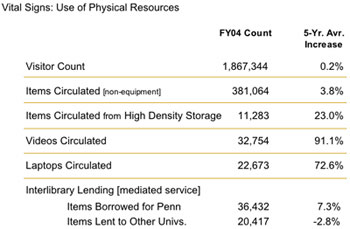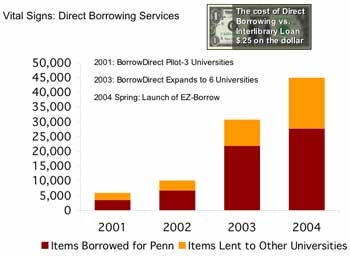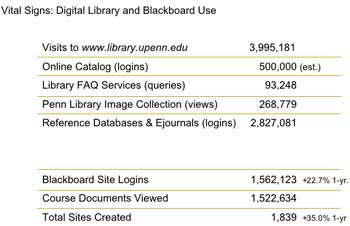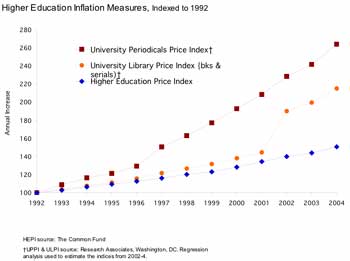
|
COUNCIL State of the University The November 3 Council meeting was primarily devoted to the annual State of the University presentations. Below are Interim Provost Peter Conn's remarks, along with the portions of his report presented by Carton Rogers and Leslie Hudson. Last week's issue contained President Amy Gutmann's report, including presentations by Omar Blaik, Craig Carnaroli and Medha Narvekar. Carton Rogers Before I begin I would like to note that I'll be on the road tomorrow and Friday meeting with Penn alums also. I'll be in Chicago, however I'll be meeting with ten alums, rather than 800, and I hope all that means is that there are far fewer Penn alums in the Chicago area than there are in Boston. I do really appreciate having the opportunity to give the Council a brief State of the Library report. As a typical librarian I come with far more information than I have time for. So I will be rolling through my presentation very quickly. Circulation Statistics It wasn't very long ago that the Chronicle of Higher Education had a picture of an empty library on its front page, asking the question: has the digital revolution rendered the academic library obsolete? You certainly can't tell that or prove that by the activities of the Penn library. Our vital signs remain extremely healthy. As you can see, our visitor counts continue to go up. What we have found and the statistics show this very clearly, when we renovate library spaces, people come. And it's not only to come to buy a latte in Mark's Café. They come to use our group study spaces, our collections, and take advantage of the expertise that the library staff has. The reason that our five-year average increase doesn't look better than it does is the fact that there are some unrenovated library facilities, which are actually showing declines in traffic. The most notable one, the biggest one, is the Biomedical Library, which has not had significant renovations since it was built in the early 1970s. Also contrary to what some people predicted, there continues to be a lot of circulation of physical items out of the University libraries. People actually still read; they take books out. They take videos out. It's actually very reassuring to see a continued increase in usage. It's not a great increase, I mean we're not seeing huge increases over all, but we see a steady increase and that's certainly heartening.
I urge you to take a close look at the Videos Circulated number. I hope you appreciate the fact that over the last few years the library has been buying significantly more videos. This is partly in support of the new cinema studies program, but it's also reflective of the fact that visual material is being used across the curriculum in ways that it hasn't been in previous years. And certainly the circulation statistics reflect an extraordinary use of our video collections. The other number that I think is particularly impressive is the laptop circulation numbers. This is a relatively new service in the libraries. We're talking about only 40 laptops that have circulated 23,000 times across the desks in Van Pelt and in Rosengarten. So clearly there is a need for and a clear pattern of use of these laptops. We are having a hard time keeping them in service; they are taking a pretty good beating and we are trying to buy more to expand the service and bring it to all the libraries on campus. I put in there also, partly for comparison sake, the current interlibrary loan activities. I just want to point out quickly a couple of things. The items borrowed include both journals and periodical articles. That shows a relatively steady increase, but nothing spectacular. Items lent have gone down. What's important about that is that it is really the comparison to what's happening on the direct borrowing side. I hope many of you have taken advantage of the BorrowDirect and EZBorrow services that the library provides. By launching these two services, we've essentially provided access to about 70 million volumes to the Penn community. Penn was one of the founding members of BorrowDirect, along with Columbia and Yale. In 2003, that expanded to include Cornell and another institution slightly up the road, where it has become wildly successful, contrary to what some people expected actually.
In 2004, we joined another group of libraries in Pennsylvania, who run a clone system, called EZBorrow, which is based primarily on BorrowDirect software, and that opens up the collections of the big libraries of the western part of the state and all the small libraries in between. This is an extraordinary service for the Penn community, and what's really important is that the cost is about a quarter of standard interlibrary loan activities. So we're providing a much more effective service at a quarter of the traditional cost. Digital Resources We're also seeing enormous amount of use on the digital side, as you might expect. It is our mission to push more and more information out to the desktop, and we are trying our best to do that. We had nearly 4 million visits to the library's main webpage. We had nearly 3 million logins for our databases and e-journals. That doesn't reflect the number of e-journals that were actually used. If you logged in we were able to count. If once you logged in you moved around and used however many number of journals, we don't have a way of actually counting that at this point. So that 3 million represents probably only a fraction of the real activity in this area.
On some days I don't like to admit that the Library actually is responsible for running Blackboard, but today I'll take some credit for it. There was a significant increase in activity in Fiscal '04. We created 35 percent more sites for Blackboard. And that resulted in about a 23 percent increase in Blackboard usage. Now all is not well in library land, and you've previously heard a little bit about this. I'm not going to spend much time at all here talking about it but just to remind you that we continue to suffer from extraordinary inflationary pressures on the information side of our budget. This graph [slide], I think portrays very nicely what the impact of this is on the library's budget. The blue line at the bottom is the higher education price index, the index back to 1992. The red line at the top is the University periodical's price index, also indexed back through 1992. And you can see that there is a growing delta between those two figures. And that's what we have to deal with in terms of purchasing new information resources for the campus.
Now some of what we do is traditional library stuff. We cancel journals; we don't buy new resources when we think there's not going to be a large user community for it, to try to stay within our budget. But we're also trying to take a much more pro-active approach to this problem. We join every consortial buying group we can possibly join, so that there is group pressure to lower costs, particularly on high-ticket items. And we've been very successful in containing costs by doing that. We are also about ready to launch a new website to the Penn community called "Winning Independence at Penn," which talks about the whole issue of the crisis in the cost of scholarly information, and begins what we hope will be a very broad and active conversation across campus about this very difficult issue. Because if you think back to that previous graph, this isn't just a problem for the libraries, it's certainly a problem for the whole academic community. How do you fund any part of your operation that is seeing that kind of extraordinary inflationary pressure? So this site will go live in the very near future and we can begin to have the kind of debate the campus needs about these issues because there are things that all of you can do to help ameliorate this problem. We're also rolling along on some very interesting digital initiatives. Just to pick a couple, we've created what we are calling the Scholarly Commons at Penn. This is a digital repository. This is in collaboration with the School of Engineering. It's to make accessible and preserve both born digital and digital versions of research papers. We've also created what we've called Video Cat or VCat which is catalog of our video holdings. This catalog leverages work already done but provides more effective access to a body of material. We're going to build an information commons and we are going to completely renovate special collections. This project will turn our Rare Books and Manuscript Library into a go-to place on campus for both academic and social activities. Thank You. I'd now like to formally pass the baton to Les Hudson, the Vice Provost for Strategic Initiatives.
Almanac, Vol. 51, No. 12, November 16, 2004 |
ISSUE HIGHLIGHTS: Tuesday,
November 16, 2004 Volume 51 Number 12 www.upenn.edu/almanac �������������������������������������������������������������������������������������������������������������� |



